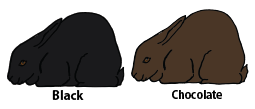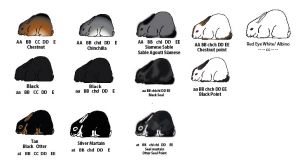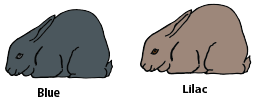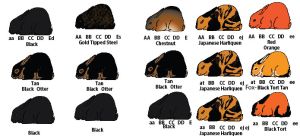Basic Color Genetics
Basic Color Genetics[edit | edit source]
This page covers the five base alleles that affect the coat color of domestic rabbits. This article focuses strictly on genotype (the genetic makeup), not phenotype (how the color appears).
- Genotype* = the black-and-white formula on the gene that produces a color.
- Phenotype* = the observable color, often used in breed standards.
Understanding genotype is crucial for predicting offspring color in breeding.
A – Agouti[edit | edit source]
The Agouti gene has three alleles:
- A – Agouti (most dominant)
- at – Tan
- a – Self (most recessive)
The Agouti locus expresses the “wild color” banding along each hair shaft. Agouti hairs have alternating bands of eumelanin (dark pigment) and pheomelanin (yellow/red), producing a “ringed” appearance. Standard Agouti colors include Chestnut (Castor), Sandy, Copper, and Chinchilla (Squirrel). Other Agouti-based patterns modified by additional genes include Red, Steel, Harlequin, and Ermine.
- Tan (at) – Eumelanin on top, pheomelanin on the bottom; expressed across the back, ears, face, belly, and inside the ears. Dominant over a (Self), recessive to A. Examples: Tan, Marten, Otter.
- Self (aa) – Requires homozygous recessive alleles. Produces solid-colored hair shafts, typically expressing the base color at the B locus and sometimes modified by the D and E loci. Examples: Black, Chocolate, Lilac, Blue, Tort.
Summary Table:
- A = Agouti (banded hair shaft)
- at = Tan (solid color on top, pheomelanin on bottom)
- aa = Self (solid hair shaft)
B – Base Color[edit | edit source]
The B locus controls the type of eumelanin expressed:
- B – Black (dominant)
- b – Brown/Chocolate (recessive)
Base color forms the foundation for many rabbit colors (e.g., Black, Chestnut, Chinchilla, Harlequin, Torts) and can be masked by other genes (white or pheomelanin-only expression).
C – Color Coverage[edit | edit source]
The C locus affects color intensity and coverage. Four primary alleles:
- C – Full Color (dominant). Expresses complete eumelanin over the body; modified by at, d, e, and En loci. Examples: Solid Blacks, Chocolates, Blues, Lilacs, Chestnuts, Steels, Harlequins.
- chd – Dark Chinchilla. Strips most pheomelanin while leaving eumelanin intact; affects Agouti most. Produces Martin, Fox, Ermine, Chinchilla, Silver-Tipped Steel, Magpies.
- chl – Light Chinchilla. Co-dominant; partially strips pheomelanin. Agouti rabbits with chl- are Siamese; self and tan rabbits with chl- are Sable. Homozygous chlchl = Seal.
- ch – Himalayan / Californian. Temperature-sensitive; color restricted to cooler points (ears, nose, feet, tail). Recessive to C, chd, chl; dominant over c.
- c – Albino. Most recessive; masks all other loci when homozygous (cc), producing red-eyed white rabbits.
D – Density[edit | edit source]
The D locus controls pigment density:
- D – Full Density (dominant)
- d – Dilute (recessive)
Dilution affects eumelanin: Black → Blue, Chocolate → Lilac. Think of it as a “brightness slider” for color intensity.
- Reference:* [A frameshift mutation in the melanophilin gene causes the dilute coat colour in rabbit (PMC)](https://pubmed.ncbi.nlm.nih.gov/24320228/)
E – Extension[edit | edit source]
The E locus controls how far color extends along the hair shaft in Agouti rabbits:
- Ed – Dominant Black. Extends B locus color across entire hair.
- Es – Steel. Extends B color most of the way; tips show pheomelanin.
- E – Regular Extension. Normal banding along hair shaft.
- ej – Japanese / Harlequin. Co-dominant; alternating patches of color.
- ee – Non-Extension / Tort. Suppresses eumelanin; tips colored, rest pheomelanin.
- References:*
- [Mutations in the melanocortin 1 receptor (MC1R) gene in rabbits](https://pubmed.ncbi.nlm.nih.gov/16978179/)
- [Slc7a11 modulated by POU2F1 and pigmentation in rabbits](https://www.ncbi.nlm.nih.gov/pmc/articles/PMC6566412/)
- [ASIP gene characterization in rabbits](https://www.sciencedirect.com/science/article/pii/S0888754309002559)
- W.E. Castle, "Who Discovered the Dominant Black Rabbit?", Journal of Heredity, 1939



